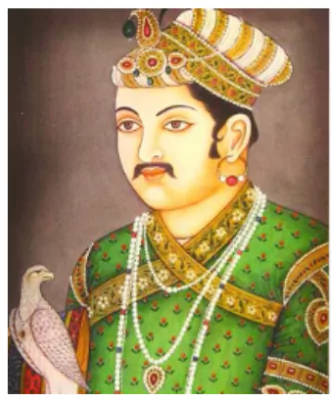During Akbar’s reign (1556-1605), coinciding with the rise of the East India Company and Queen Elizabeth I, significant conquests and consolidations marked the Mughal Empire. From his early days in Punjab to the annexation of vast territories across India, Akbar’s rule reshaped the region’s political landscape.
Akbar’s Reign: Conquests, Consolidation and Chieftain Encounters
1. Key Events in Akbar’s Life:

- He was born in 1542 at Amarkot during Humayun’s refuge and after Humayun died in 1556.
- 13-year-old Akbar was crowned in Kalanaur, Punjab.
- Akbar’s final resting place is at Sikandra (near Agra).
- Bairam Khan: He was Akbar’s tutor and advisor to Humayun.
- He served as a regent from 1556-60, overseeing early conquests that expanded the Mughal Empire from Kabul to Jaunpur, including territories like Gwalior and Ajmer.
- External Challenges: Adil Shah appointed Hemu as wazir and titled him Vikramajit to expel the Mughals. Hemu conquered Agra and proceeded to Delhi.
- However, Bairam Khan defeated him at the second battle of Panipat(1556), neutralising the Suri threat.
- Internal Challenge: Bairam Khan was dismissed due to his arrogance towards other nobles, and his rebellion was swiftly crushed by Akbar.
- He was assassinated en route to Mecca and his family was relocated to Delhi, where his son, Abdur Rahim, rose to prominence in Akbar’s court and was bestowed the title Khan-e-Khanan.
Enroll now for UPSC Online Course
2. Major Conquests in India
- Second Battle of Panipat(1556): Afghans posed a persistent threat to the Mughals post-Humayun’s death.
- Hemu, a trader turned commander, emerged as a significant Afghan leader.
- Hemu and the Afghan forces were defeated in 1556 by the Mughal forces under Akbar.
- Struggle for Wakalat:
- Post-Bairam Khan’s downfall, factionalism increased among the nobility.
- The wakil post, combining financial and military powers, became a point of contention.
- Akbar’s interventions aimed to strengthen central control over the nobility.
- Revolt of Uzbek Nobles:
-
- Uzbek nobles, disaffected, rebelled against Mughal authority.
- Akbar diplomatically isolated and militarily defeated the Uzbeks, restoring stability.
- Subsequent revolts, including that of Mirza Hakim, were swiftly quelled, cementing Akbar’s authority.
- Malwa(1562): Defeated Baz Bahadur (last sultan of Malwa; capital mandu); who later surrendered to Akbar and joined his service.
- Gondwana(1564): Rani Durgavati resisted Mughal expansion but was defeated.
- Mewar(1568): Captured Chittor after the retreat of Rana Udai Singh. With the fall of Chittor, several Rajput states, such as Ranthambore and Jodhpur, also surrendered.
- Gujarat(1573): From Muzaffar Shah, later Gujarat became a launch pad for the annexation of Deccan.
- Battle of Haldighati(1576): Akbar secured a decisive win in the Battle of Haldighati where Maharana Pratap suffered severe defeat at the hands of the Mughal army under Man Singh.
- This victory resulted in the acceptance of Akbar’s suzerainty by most leading Rajput rulers.
- Annexation of Bihar and Bengal(1576): Defeated Daud Khan, the Afghan ruler of Bihar and Bengal subsequently annexing both provinces to the Mughal empire in 1576.
- North and North West: Defeated Mirza Hakim of Kabul. His subsequent conquests of Kashmir in 1586 and Sindh in 1591 facilitated further consolidation in the northwest.
- Deccan region: In 1591, occupied the Khandesh region. By 1596, Berar was acquired from Chand Bibi, the regent of Ahmednagar.
- By 1600, parts of Ahmednagar were under Mughal control.
- Mughal Encounters with Chieftains: After Babur and Humayun rule, Akbar faced rebellions from Afghan and local chieftains.
- Akbar initially engaged in wars with them, but eventually gained their support during conquests.
3. Relations with Chieftains:
- Integration of Chieftains: Chieftains were often left to govern their territories after submitting to Mughal rule.
- They collected revenue according to local customs, not Mughal rules.
- Many chieftains joined the Mughal military, receiving jagirs and mansabs.
- Around 61 chiefs were given mansabs during Akbar’s reign alone.
- This trend continued under successive Mughal rulers.
- Rebellion and Response: Rebellions by chieftains often stemmed from issues like unpaid revenue.
- The Mughals didn’t seize their territories but sometimes temporarily removed them as a reprimand.
- Later, they or their family members were reinstated.
- Mughals benefited by incorporating chieftains into nobility, ensuring peace and expanding the empire.
- Chieftains retained autonomy over their territories, receiving jagirs and mansabs for their loyalty.
- This arrangement provided security against enemies and rebellions.
Enroll now for UPSC Online Classes
Conclusion
Akbar’s reign marked a period of remarkable conquests and consolidation for the Mughal Empire. Through strategic military campaigns and diplomatic negotiations, Akbar expanded his territory from Kabul to the Deccan region. His policies of incorporating chieftains into the Mughal administration and granting them autonomy ensured stability and security, contributing to the longevity and prosperity of the empire.
![]() May 15, 2024
May 15, 2024
![]() 9077
9077
![]() 0
0
